|
1.
CENTRAL AND WEST AFRICA
Regional update
International demand remains muted
The timber sector across the region ended August with
prices remaining broadly stable, though international
demand is still muted. Political developments are shaping
the business climate with presidential elections taking
place in Cameroon and Congo and local elections will be
held in Gabon.
At the same time unpredictable weather patterns are
creating difficulties. Cameroon is experiencing widespread
flooding that is affecting communities and transport
networks while the Congo has experienced heavy flooding
in Brazzaville and across the river in Kinshasa.
Gabon
According to the First Quarter 2025 Sectoral Outlook
published by the Ministry of Economy and Finance at the
end of March the composite index for activities in the
timber sector increased by 15% compared to the previous
quarter. This increase, as stated in the Sectoral Outlook
publication, was driven mainly by demand from China.
See: https://www.gabonreview.com/industries-du-bois-une-
hausse-de-153-au-premier-trimestre-2025-sous-limpulsion-de-la-
chine/#respond
In-country producers report adequate supplies of Azobe
logs and sawnwood with European buyers, particularly in
the Netherlands which continues to prioritise Azobe for
dragline mats. However, demand for Okan has picked up
as it is now being used in combination with Azobe for the
same application. This has boosted Okan prices which
showed some firming towards the end of the month.
The Okoume market remains steady with continued
domestic sales from millers in the NKok zone. Milling for
the domestic market is continuing at a steady pace but
production for export proceeds slowly.
After the extended rainy season repairs to laterite roads are
underway across the south including the Okonja–
Makoukou road. August and September mark the middle
of the dry period with cooler temperatures and improved
transport conditions.
Rail transport remains a critical issue. Producers in the
south are requesting more wagons but SETRAG gives
priority to manganese shipments. Recent intervention at a
ministerial level slightly improved allocations for timber.
Public and government frustration with SETRAG remains
high following repeated delays and poor track
maintenance. Although SETRAG has received funds for
repairing tracks and bridges protests continue over its
performance.
Producers report the availability of containers is adequate
and port operations are running normally though some
report port charges for timber have increased.
Since January this year every bundle of sawn timber must
carry GPS data linked to the logs from which it was milled
and this is checked at Owendo Port before shipment.
Enforcement has been tightened under a Presidential
Directive.
By year-end, all concession holders must submit aerial
surveys of their areas carried out by government operators
using satellite imagery. Forestry officials are already
employing drones to monitor logging activities.
Cameroon
Cameroon has been significantly affected by flooding
which has disrupted timber movement and caused
difficulties for local communities. Despite this, export
activity has continued at modest levels.
Azobe supplies remain stable and readily available and
Ayous and Sapele are trading at normal volumes. Prices
for these species have not shown significant change since
early August.
Sawmill activity in Cameroon has reportedly slowed as
several Chinese operators have ceased operation. The
political uncertainty ahead of the October presidential
elections is weighing on sentiment in the sector. Overall,
sawmills are operating at reduced capacity and expansion
plans are on hold.
Azobe continues to show steady demand, particularly in
the Dutch market. However, forestry authorities are
imposing limits on available sizes which is said to
constrain supply. In contrast, demand for redwoods is
reportedly weakening. Operators had built log stock earlier
in the season and currently hold about two months of
reserves reducing the pressure to ramp up harvesting.
Transportation of timber to port is running normally and
container availability is not an issue. Port operations are
said to be stable with no significant disruptions reported.
Producers say order levels are stable to low depending on
the species. Azobe demand provides some support but
weakening interest in redwoods is slowing activity. In
general, the industry is now more focused on political
developments than on investment or expansion of
operations.
Republic of Congo
Heavy flooding around Brazzaville and on the opposite
side of the river in Kinshasa has strained infrastructure and
delayed timber transport. The presidential election is
adding to business uncertainty but producers say prices for
most species remain stable. Supply is adequate and
harvesting continues at moderate levels.
Through the eyes of industry
The latest GTI report lists the challenges identified by the
private sector in the Republic of Congo and Gabon.
See: https://www.itto-
ggsc.org/static/upload/file/20250819/1755566095153001.pdf
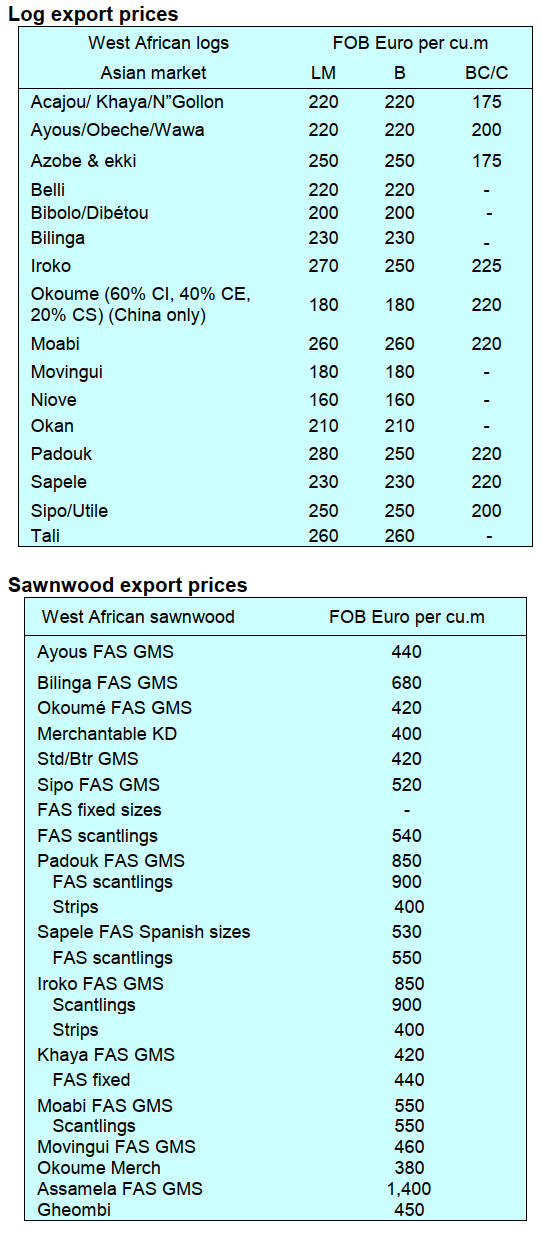
2.
GHANA
Sliced veneer exports record year-on-year growth
Available data on wood product exports provided by the
Timber Industry Development Division (TIDD) of
Ghana’s Forestry Commission (FC) for the period January
to June 2025 show that sliced veneer exports recorded a
20% rise in volume and 32% rise in value. This resulted
from increased demand in every major market.
For the first six months of 2025 the cumulative volume of
veneer shipments improved to 3,545 cu.m, from 2,965
cu.m for the same period in 2024.
The country’s export earnings also jumped from Eur 3.4
million in 2024 to Eur 4.5 million in 2025.
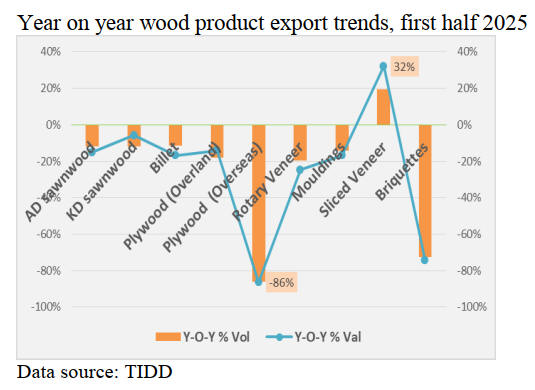
The TIDD data also revealed that sliced veneer accounted
for 2% and 3% of the total export volumes in 2024 and
2025 respectively. Veneer exports accounted for 6% in
2024 and 7% of 2025 of total export earnings.
Sliced veneer is categorised as a Secondary Wood
Products (SWP), a category which also includes kiln-dried
sawnwood, rotary veneer, plywood, briquettes and kiln-
dried boules. These together accounted for 39% of the
total export revenue for the first half of 2025, a marginal
increase of 1% over that for 2024 for the same period.
However, revenue from the Primary Products export
dipped from 57% in 2024 to 56% in 2025, while Tertiary
Products maintained 5% of the total export receipts in both
years
Species processed to sliced veneer included chenchen,
asanfina, koto, sapele, makore, edinam, yaya, ceiba and
candollei. The main markets included Morrocco, Italy, US,
Denmark, UAE, Spain, India and Belgium.
First shipments of FLEGT licensed timber
Ghana has begun the export of timber under the new
European Union (EU) framework, following the
successful validation processes of the Voluntary
Partnership Agreement (VPA) with the EU.
The Forestry Commission has issued the first six
certificates to five Ghanaian companies to export wood
products to the EU under the Forest Law Enforcement,
Governance and Trade (FLEGT) licensing regime.
The certificates from the Forestry Commission verify that
the wood products are derived from legally harvested logs
and processed in accordance with national laws. These
licenses mark a milestone for Ghana in sustainable forest
governance and the trade in legal timber. Dr. Hugh Brown,
Acting Chief Executive of the Forestry Commission
described the launch of Ghana’s FLEGT Licenses as a
historic milestone, marking 16 years of reform and
collaboration since the signing of the Voluntary
Partnership Agreement (VPA) with the EU in 2009.
He highlighted the development of the Timber Legality
Assurance System (TLAS) from forest to market. He
indicated this system has improved accountability, enabled
data-driven decision-making and promoted inclusive
governance involving all key stakeholders.
The Minister for Lands and Natural Resources, in a speech
read on his behalf, also described the FLEGT License as a
major step toward the sustainable management of Ghana’s
forest reserves.
The Deputy Head of the EU Delegation, Mr. Jonas Claes,
praised Ghana’s commitment and leadership. He stated
that the move reinforces Ghana’s role in the legal timber
trade, improved forest governance and the fight against
illegal logging.
See: https://fcghana.org/ghana-pioneers-flegt-licensing-in-africa/
and
https://www.myjoyonline.com/ghana-begins-legal-timber-export-
under-new-eu-legal-framework/
IFC to support Ghana boost agribusinesses
Ghana’s Millennium Development Authority (MiDA) is
set to collaborate with the International Finance
Corporation (IFC) to transform the country’s agricultural
sector through a major boost in agribusiness investment
and development.
This was disclosed during a working visit by Kyle
Kelhofer, IFC Senior Manager for Ghana, Liberia and
Sierra Leone, to the Chief Executive Officer of MiDA,
Mr. Alexander Kofi-Mensah Mould. The meeting was
centered on strategic partnerships aimed at unlocking the
potential of key agricultural enclaves across the country.
The partnership marks a significant step toward
transforming Ghana’s agricultural landscape and
positioning the country as a key player in regional food
production and agribusiness.
See: https://thebftonline.com/2025/07/14/mida-partners-with-
ifc-to-boost-agribusiness/
Ghana to review investment Act to attract investors
The President has announced his government will remove
the minimum capital requirements for foreign investors
under a revised Ghana Investment Promotion Centre
(GIPC) Act.
Speaking at the sidelines of the Ghana Presidential
Investment Forum on the Ninth Tokyo International
Conference on African Development (TICAD-9) in
Yokohama, Japan the President said the amendment is
aimed at making Ghana’s business landscape more
attractive to investors of varying sizes.
He mentioned small investors will be able to establish a
business in Ghana, this he said would ease entry barriers
and open the way for small and medium-scale investors to
operate in Ghana.
The announcement is intended to woo investors from the
Asia pacific region to strengthen trade and investment
links in industrialisation, agro-processing and exports with
Ghana.
Under the existing law, GIPC Act 2013 (Act 865) foreign
investors are required to meet a minimum equity
contribution ranging from US$200,000 to US$1,000,000
before setting up businesses.
Business and economic analysts have cautioned
government to advance cautiously, so as not to expose
local businesses and enterprises, especially small and
medium-scale businesses, to unfair competition.
See: https://www.graphic.com.gh/news/general-news/mahama-
scraps-foreign-investor-minimum-capital-requirement-under-
revised-gipc-act.html
and
https://gipc.gov.gh/minimum-equity-requirements/
Bank of Ghana policy rate now 25%, down from 28%
The Monetary Policy Committee (MPC) of the Bank of
Ghana (BoG) has reduced the policy rate to 25% from
28%. The Governor of the BoG, Dr. Johnson Asiama
made the announcement at a press briefing after majority
of the 7-member committee voted to reduce the policy
rate.
The year-on-year Inflation in Ghana for July 2025 slowed
down to 12% from the 14% recorded in July 2024. This is
the seventh consecutive decline this year and the lowest
since October 2021 according to data from the Ghana
Statistical Service.
In related news, at a meeting with chief executives of
banks the Governor indicated the gains made in stabilising
the banking system and urged commercial banks to
translate this into tangible benefits for the real economy.
See: https://www.graphic.com.gh/news/general-news/ghana-
news-bog-drops-policy-rate-to-25.html
and
https://www.myjoyonline.com/macroeconomic-stability-must-
translate-into-growth-bog-governor-tells-banks/
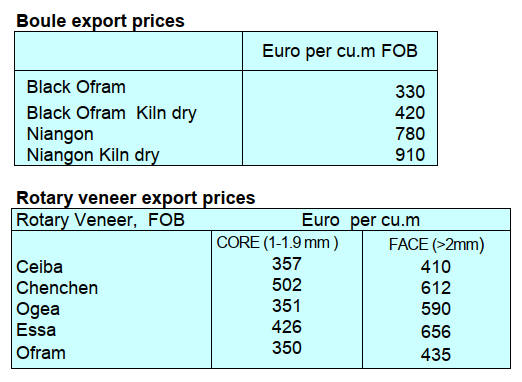 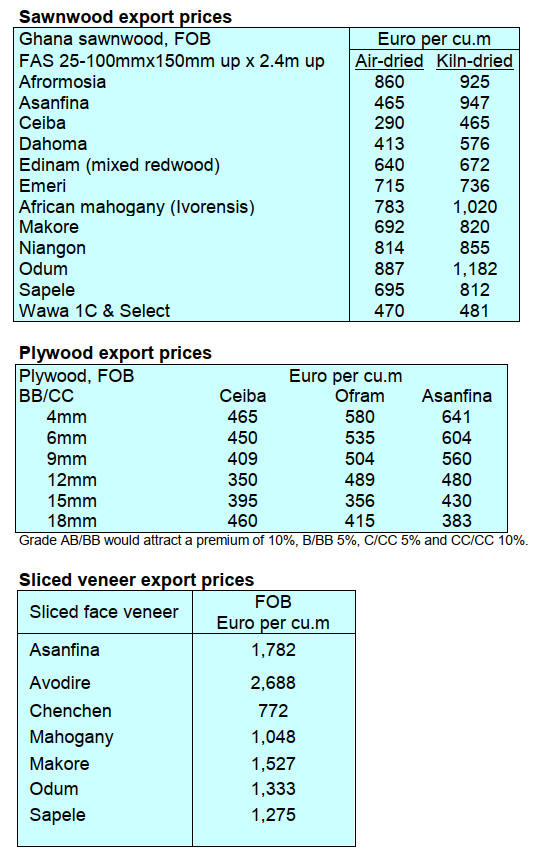
Through the eyes of industry
The latest GTI report lists the challenges identified by the
private sector in Ghana.
See: https://www.itto-
ggsc.org/static/upload/file/20250819/1755566095153001.pdf
3. MALAYSIA
Exports resilient despite tariffs and slowdown in global
demand
Malaysia’s timber exports continue to show resilience
achieving a total value of RM9.03 billion in the first five
months of this year despite tariffs, a slowdown in the
global economy and the challenge of preparing for the
EUDR.
Plantation and Commodities Deputy Minister, Chan Foong
Hin, acknowledged the industry’s concerns over the
EUDR which demands a high level of supply chain
transparency and verification. He said that the ministry is
working closely with relevant agencies to ensure full
compliance throughout the entire timber value chain with
a strong focus on traceability, transparency and legality.
Chan also addressed domestic concerns over the expanded
Sales and Service Tax (SST) and US trade tariffs which
have pushed up costs and eroded competitiveness.
The SST, he said, has increased operational expenses by
8–12% which has pushed up prices across the supply chain
and particularly affected small and medium enterprises.
Looking ahead, Chan said the domestic timber industry’s
future will be shaped by three major trends, sustainability,
digital transformation and evolving consumer lifestyles.
“Through the National Agri-commodity Policy 2021–
2030, we are addressing these challenges via five key
thrusts: sustainability, productivity, value creation, market
development and inclusivity.
See: https://thesun.my/business-news/malaysian-timber-exports-
resilient-in-face-of-global-headwinds-LF14661864
Malaysia's trade hit a record high in July 2025
Malaysia's international trade hit a record high in July
2025 but analysts cautioned that uncertainties from US
tariffs and a cloudy semiconductor outlook could weigh on
momentum in the months ahead.
According to the Ministry of Investment, Trade and
Industry (MITI), July trade rebounded by almost 4% year
on year to RM265.92 billion, the strongest monthly
performance on record. Exports rose 7% to RM140.45
billion, the highest since September 2022, while imports
rose 0.6% to RM125.47 billion.
The timber industry, especially the furniture sector, is
apprehensive of recent news that US President has
directed his administration to investigate imports of
furniture into Unites States that may lead to higher tariffs
by October.
See:
http://theborneopost.pressreader.com/article/282162182313008
Pioneer forest restoration project
Face the Future, in collaboration with the Sabah
Foundation, has been working on restoration and
protection of the degraded forest in Sabah since 1992.
Face the Future is a NGO based in the Netherland.
Through enrichment planting using indigenous species the
project aims to contribute to restoring the natural
biodiversity of Sabah’s rainforest. The primary species
selected for the project include indigenous dipterocarps
from the genera Shorea, Parashorea, Dipterocarpus,
Vatica, Hopea and Dryobalanops. These species are well-
suited as pioneers in open and severely degraded areas.
See:
https://theborneopost.pressreader.com/article/281629606361895
and
https://www.yayasansabahgroup.org.my/conservation_managem
ent.cfm
Black wooden pellet
It is reported that a major timber group based in Sarawak
has signed a letter of intent (LOI) with Japan’s Kobe Steel
to develop black wooden pellet biomass, a substitute for
coal in power generation and industrial heat production.
Under the LOI, a joint feasibility study will be conducted
for a plant capable of producing 300,000 tonnes per year
of black pellets.
Black pellets, created through thermal treatment
(torrefaction) of white pellets under specific conditions,
have the calorific value comparable to coal and are
expected to be a low-CO2 alternative with the potential to
be utilised as both a fuel for power generation and a raw
material for steelmaking.
See:
https://ceomorningbrief.theedgemalaysia.com/article/2025/1013/
Home/12/767531
MTCC invites comments
Since 1999 the Malaysian Timber Certification Council
(MTCC) has been advancing sustainable forest
management through the Malaysian Timber Certification
Scheme (MTCS). Following the scheme’s last re-
endorsement in 2021 by the Programme for the
Endorsement of Forest Certification (PEFC), MTCS
standards are undergoing a review for re-endorsement to
align with national and international requirements.
The public statement from MTCC says this is ongoing
commitment to strengthen sustainable forest management
practices to ensure long-term sustainable environmental,
social and economic benefits from our forests in
Malaysia.
To ensure a transparent and participatory process as
outlined in MTCS ST 1001:2021 – Standards Setting
Procedures for Forest Management Certifications, a multi-
stakeholder Standard Review Committee (SRC) will be
formed. This committee will be a key platform for
enhancing the credibility, inclusivity and transparency of
the MTCS.
The MTCS ST 1001:2021 document can be found at:
https://mtcc.com.my/wp-content/uploads/2021/10/MTCS-
ST-1001-2021-Standard-Setting-Procedures-for-FMC-
Standards-30-Sep-2021.pdf
For more information see:
https://mtcc.com.my/public-announcement-standard-review-
committee-src-endorsement-of-the-malaysian-timber-
certification-scheme/
Through the eyes of industry
The latest GTI report lists the challenges identified by the
private sector in Malaysia.
See: https://www.itto-
ggsc.org/static/upload/file/20250819/1755566095153001.pdf
4.
INDONESIA
Contribution of manufacturing to econmy
dips
The Indonesian Furniture and Handicraft Industry
Association (HIMKI) has raisied concerns about the
declining share of the manufacturing sector in the nation's
GDP, as it has fallen from 28% in 2010 to below 19%
currently.
The furniture and handicraft sectors, despite their
importance to the creative economy are particularly
affected by this downturn. The sector faces many
challenges, including high production and logistics costs,
dependence on imported raw materials, hurdles to access
financing and fierce international competition.
The Association emphasised the need for an integrated
approach, including developing industrial clusters,
prioritising design and utilising international trade fairs for
promotion.
Despite the challenges HIMKI sees several growth
opportunities, particularly over the next five years. The
global trend toward sustainability and eco-friendly
products presents a new market for furniture made from
materials like bamboo and rattan. Additionally, trade
agreements such as the Indonesia–European Union
Comprehensive Economic Partnership Agreement (IEU-
CEPA) could provide tariff benefits for Indonesian goods.
The Chairman of HIMKI has said a fundamental "mental
transformation" is necessary on the part of entrepreneurs.
He stressed that the industry's habit of copying designs
from buyers or other producers creates an image of ‘low-
cost factory’ rather than a hub of creativity leading to
businesses competing mainly on price.
Additionally, a focus on quantity over quality and a lack of
collaboration among businesses weaken the industry's
international position.
See: https://www.msn.com/id-id/berita/other/sektor-manufaktur-
ri-lesu-sektor-mebel-dan-kerajinan-ikut-tertekan/ar-
AA1KH6nF?ocid=BingNewsVerp
and
https://koran-jakarta.com/2025-08-21/indonesia-bisa-jadi-
pemimpin-industri-kerajinan-dunia-asal-ubah-mentalitas
To grow, furniture and woodworking industries need
the latest technologies
Erie Sasmito, the General Chairman of the Indonesia
Furniture & Craft Promotion Forum (IFPF) is urging
enterprises to adopt modern technology to expand business
and improve global competitiveness. He said “utilising the
latest technology can make the industry more efficient and
better equipped to handle tough global competition”.
The Secretary-General of the Indonesian Sawmill and
Woodworking Association (ISWA), Choiril Muchtar,
added that only an estimated 24% of the industry's
potential has been exploited.
He noted that new machinery and technology can help
reduce raw material costs which typically make up 40-
60% of total production costs while simultaneously
boosting productivity and product quality.
A key event for assessing technology is IFMAC
WOODMAC 2025, an exhibition that will take place from
September 24-27 at the Jakarta International Expo
(JIExpo) Kemayoran.
See: https://www.msn.com/id-id/berita/other/industri-furniture-
dan-perkayuan-indonesia-perlu-manfaatkan-teknologi-untuk-
perbesar-bisnis/ar-AA1KqDX5?ocid=BingNewsVerp
Indonesia welcomes foreign support for forest
rehabilitation
Indonesia's Forestry Minister, Raja Juli Antoni, announced
that the country is open to international collaboration and
funding for forest conservation and rehabilitation.
Speaking at the initial meeting for the REDD+ GCF Phase
II RBP, he stated that Indonesia is committed to protecting
its forests and supporting community welfare and
welcomes global involvement.
See: https://en.antaranews.com/news/372969/indonesia-opens-to-
foreign-support-for-forest-rehabilitation
In other news, Minister Raja Juli Antoni is promoting the
integration of the forestry sector into Indonesia's carbon
trading scheme as part of efforts to rehabilitate degraded
land and reduce deforestation.
He emphasised the urgency of revising Presidential
Regulation No. 98 of 2021 to facilitate the opening of a
voluntary carbon market thus enabling private sector
investment. With around 6.5 million hectares of degraded
land in need of rehabilitation, the Minister believes that
allowing private participation in carbon trading will not
only support environmental goals but also generate state
revenue through taxes and related mechanisms.
See: https://www.antaranews.com/berita/5031821/menhut-kejar-
implementasi-perdagangan-karbon-sektor-kehutanan
Promoting non-timber forest products, a forest
rehabilitation market
The Ministry of Forestry organised a Forest and Land
Rehabilitation (RHL) market to promote non-timber forest
products (NTFPs) from all over the country. This market
aims to help communities sell forest products that they
have planted to restore critical land. The Directorate
General of Watershed Management and Forest
Rehabilitation (Ditjen PDASRH) are leading the initiative.
According to Dyah Murtiningsih, the Director General of
Watershed Control and Forest Rehabilitation, the RHL
market is a practical example of how forest and land
rehabilitation can support food security in Indonesia. The
Ditjen PDASRH also plans to develop a comprehensive
program for natural resource management with a focus on
empowering communities.
See:
https://lestari.kompas.com/read/2025/08/20/152817386/dorong-
produk-hasil-hutan-bukan-kayu-kemenhut-gelar-pasar-
rehabilitasi-hutan.
and
https://www.jawapos.com/index.php/image/detail/18505/kemenh
ut-gelar-pasar-pasar-komoditas-rehabilitasi-hutan-dan-lahan
400,000 hectares designated as Customary Forests
The Ministry of Forestry has designated 400,000 hectares
of land as Customary Forests to recognise and protect the
rights of indigenous communities.
According to the Minister these actions are intended to
provide legal certainty and protection for indigenous
communities over their ancestral lands which have been
managed sustainably for generations. The Minister
emphasised that this achievement is a result of strong
synergy between national policy, various stakeholders and
indigenous communities.
See: https://esgnow.republika.co.id/berita/t0sama487/menhut-
raja-juli-klaim-hampir-400-ribu-hektare-hutan-adat-sudah-diakui
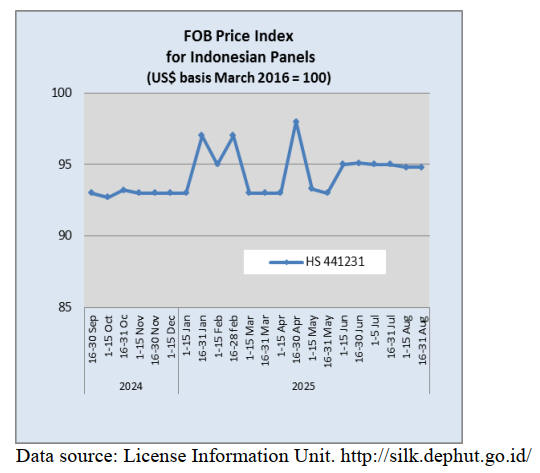
Through the eyes of industry
The latest GTI report lists the challenges identified by the
private sector in Indonesia.
See: https://www.itto-
ggsc.org/static/upload/file/20250819/1755566095153001.pdf
5.
MYANMAR
Myanmar to hold first phase of general
election in
December
Myanmar government has announced the initial phase of a
general election will be held on 28 December, the first
national polls in nearly five years. The election
announcement outlines a phased voting process planned
for December and January. However, while 55 political
parties have registered for the upcoming polls, with nine
planning to compete nationwide, the election is expected
to be dominated by candidates backed by the military.
.
The interim administration has stated its intent to hold
voting in over 300 constituencies, including in areas
currently experiencing heavy fighting with armed
opposition groups.
See: https://www.channelnewsasia.com/asia/myanmar-junta-
new-election-details-5306766
And
https://www.straitstimes.com/asia/se-asia/myanmar-to-hold-first-
phase-of-general-election-on-dec-28-state-television-reports
Timber trade flows have shifted dramatically
According to a Forest Trends study, Myanmar’s timber
industry has experienced significant upheaval since 2021
due to sanctions, conflict and altered trade dynamics.
While timber exports have exceeded US$1.27 billion since
2021, the markets have shifted dramatically.
By 2024, China and India dominated imports at 88% and
about 20% respectively, while exports to Western
countries, which constituted 25% of trade in 2022, have
dropped to virtually zero. Since 2021, Myanmar has
ceased publishing trade data.
See: https://www.forest-trends.org/wp-
content/uploads/2025/02/myanmars-forest-sector-since-the-
coup_FINAL.pdf
New measures for currency control
The local and regional press has reported Myanmar's
government is undertaking a multi-pronged strategy to
exert control over its economy these measures include
enforcing strict capital controls on exporters, physically
seizing control of the border trade and establishing an
alternative financial channels.
Myanmar's Central Bank has mandated the swift
repatriation and settlement of all export earnings.
Companies must bring their foreign income back into the
country within strict deadlines: 30 days for exports to
Asian countries and 60 days for those to non-Asian
countries. Failure to comply will resultss in harsh
penalties,say the authorities.
Pivot away from the US dollar
To reduce its dependency on the US dollar, Myanmar has
partnered with Russia. The Russian Central Bank
announced it will accept the Myanmar Kyat for direct
exchange, allowing the two nations to trade using their
local currencies, the ruble and the kyat. This enables
Myanmar to pay for Russian imports without using scarce
US dollar reserves.
See -
https://burmese.dvb.no/post/719373, https://burmese.dvb.no/post
/721055
and
https://www.thestar.com.my/aseanplus/aseanplus-
news/2025/08/19/myanmar-border-closure-cripples-thai-exports-
worth-billions
6.
INDIA
Sawnwood and veneer price indices delined
in June
The annual rate of inflation based on the all India
Wholesale Price Index (WPI) was -0.13% in June. The
negative rate of inflation in June 2025 was primarily due
to decreases in the price of food articles, mineral oils,
manufacture of basic metals and crude petroleum and
natural gas.
The index for manufacturing declined by 0.07% to 144.8
in June 2025 from 144.9 for May 2025. Out of the 22 NIC
two-digit groups for manufactured products, 11 groups
witnessed an increase in prices, 6 groups a decrease and 5
groups witnessed no change in prices.
Some of the important groups that showed month on
month increased prices were other manufacturing,
machinery and equipment, other transport equipment,
pharmaceuticals, medicinal chemical and botanical
products, computes, electronic and optical products.
Some of the groups that witnessed a decrease in prices in
June were manufacture of basic metals, food products,
fabricated metal products (except machinery and
equipment), tobacco products, rubber and plastics
products.
The price index for wood panels in June was unchanged
from May. The sawnwood price index in June was down
compared to a month earlier and there was also a decline
in the index for veneers.
See: https://eaindustry.nic.in/
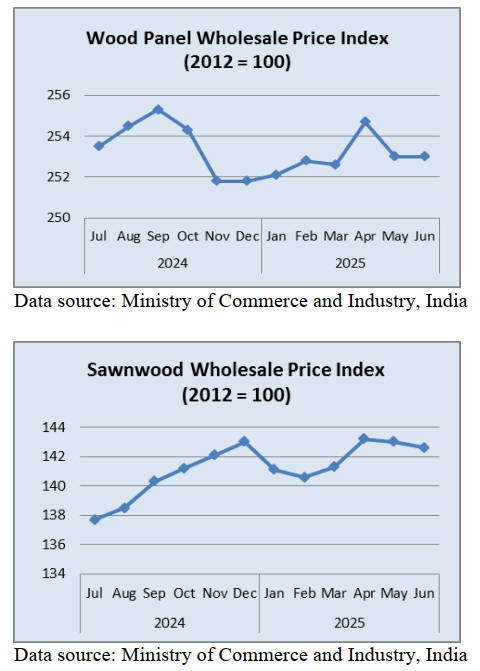 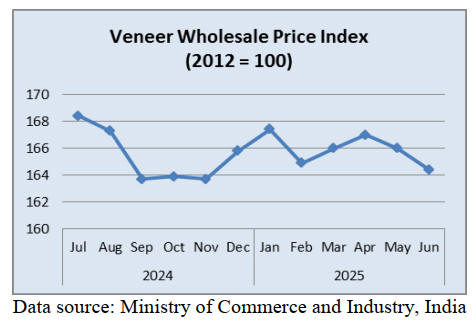
CREDAI report - remarkable surge in residential real
estate market
In a press release, the Confederation of Real Estate
Developers’ Associations of India (CREDAI) announced
that, in collaboration with CRE Matrix, a report, ‘India
Housing Report July 2025’ has been published.
The press release says the report highlights significant
regional variations with the National Capital Region
(NCR) leading the market with a 26% revenue share,
fueled by a 21% increase in sales value and a 32% surge in
average prices.
The Mumbai Metropolitan Region (MMR) followed
closely with a 23% revenue share, recording a 9% growth
in sales value and 75,000 units sold, with a 16% increase
in average prices.
In the south, Chennai emerged as a standout performer
achieving a 23% increase in sales value with 11,000 units
sold and a 12% rise in average prices. New launches in
Chennai grew from 14,000 to 19,000 units, though the
market share of homes fell.
The decline in new launches across most cities signals a
cautious approach by developers amid rising costs says the
report. However, the robust growth in transaction values
highlights the sector’s resilience and the increasing
premiums in the market.
Commenting on the report, Shekhar Patel, president of
CREDAI, said “we are witnessing a decisive shift in
homebuyer preferences across India. The demand is
clearly moving towards larger, better-located and more
premium homes—reflecting rising aspirations and
improved purchasing power. A 21% growth in NCR’s
housing value, despite lower volumes, is a clear indicator
that quality and location are now more important than
quantity.
See: https://credai.org/media/view-details/?file_no=93
Indian furniture brands innovating to meet evolving
demands of domestic consumers
Furniture Design & technology (FDT), an Indian trade
magazine, has suggested India’s furniture industry is
poised to become a formidable player in the global market.
The sector is projected to be worth US$34 billion by 2028
as domestic consumers shift to organised retail outlets as
opposed to the traditional craft sector.
Indian brands are said to be innovating to meet the
evolving demands of consumers. The rise in demand for
customised furniture is another trend which, says FDT, is
fueled by factors such as urbanisation, increased
disposable incomes and a growing preference for quality
home furnishing.
See: https://furnituredesignindia.com/magazine/Current-Issue
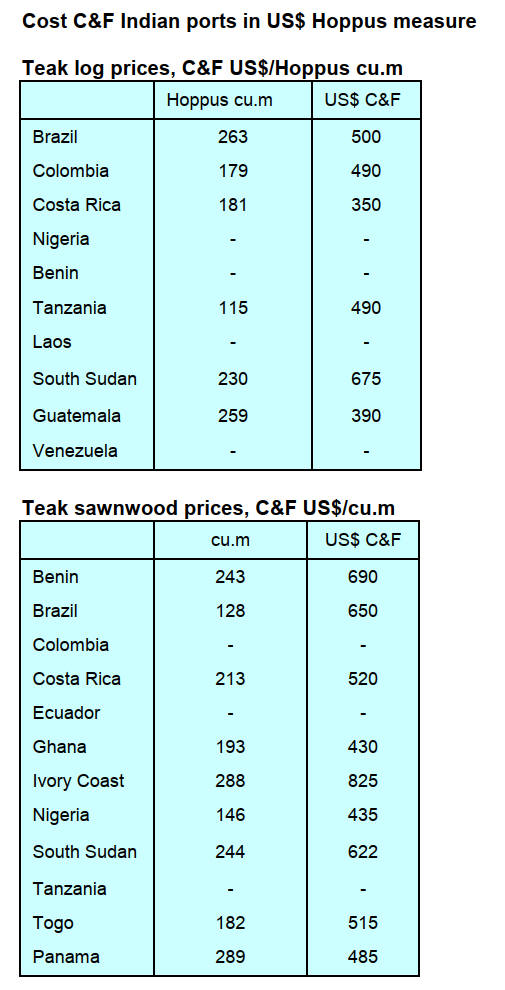 
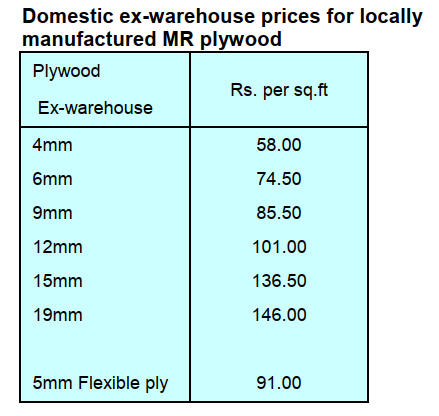
7.
VIETNAM
Wood and Wood Product (W&WP) trade
highlights
According to the Vietnam Customs Department, in July
2025 W&WP exports reached US$1.47 billion, up 9%
compared to June 2025 and up 6% year-on-year. Of this,
WP exports alone fetched US$ billion, up 9% compared to
June 2025 and up 5% year-on-year.
In the first 7 months of 2025 W&WP exports amounted to
USUS$9.6 billion, up 8% over the same period in 2024
with WP exports contributing US$6.6 billion, up 8% over
the same period in 2024.
W&WP exports to Middle East markets in July 2025 were
recorded at USUS$9.8 million, up 19% compared to July
2024. In the first 7 months of 2025 W&WP exports to the
Middle East markets earned US$67.7 million, up 38%
over the same period in 2024.
In July 2025 bedroom furniture exports were valued at
US$182 million, down 6% compared to July 2024. In the
first 7 months of 2025 exports of bedroom furniture
brought in about US$1.2 billion, up 5% over the same
period in 2024.
In July 2025 W&WP imports to Vietnam were valued at
US$309.5 million, up 17% compared to July 2024. In the
first 7 months of 2025 W&WP imports were valued at
US$1.8 billion, up 19% over the same period in 2024.
Vietnam's poplar imports in July 2025 were 37,600 cu.m,
worth US$17.1 million, up 8% in volume and 9% in value
compared to June 2025. Compared to July 2024 the value
of imports decreased by 9% in volume but increased by
4% in value.
In the first 7 months of 2025 poplar imports were
estimated at 196,900 cu.m, worth US$84.9 million, down
10% in volume but up 2% in value year-on-year.
Vietnam's imports of raw wood (log and lumber) from the
ASEAN region in June 2025 dropped to 65,840 cu.m, with
a value of US$13.43 million, down 29% in volume and
39% in value compared to May 2025.
In the first 6 months of 2025, imports of raw wood from
ASEAN amounted to 441,390 cu.m, with a value of
US$114.72 million, down 5% in volume and 9% in value
over the same period in 2024.
Viet Nam timber enterprises eye US-based
manufacturing
In response to US reciprocal tariffs some Vietnamese
wood manufacturers are considering manufacturing in the
US, said Ngo Sy Hoai, Vice Chairman and General
Secretary of the Vietnam Timber and Forest Products
Association (Viforest).
The Ministry of Agriculture and Environment reported
that exports of agricultural, forestry and fishery products
in the first seven months of 2025 reached US$39.68
billion, up 15% year-on-year. Of this, wood and wood
products earned US$9.67 billion, an increase of 8% over
the same period.
In the period January to July agricultural-forestry-fisheries
earned a trade surplus of US$11.52 billion with wood and
wood products making the largest share at US$7.7 billion,
up 4% over the same period in 2024.
The US remains Vietnam’s largest market for wood and
wood products accounting for 56% of total exports in the
first seven months of 2025, followed by Japan and China,
with 12% and 11% respectively.
Viet Nam’s Decree on forest carbon credits
The Government is formulating a new Decree to provide a
legal basis for the commercialisation of forest carbon
credits. This move comes after Vietnam’s first successful
sale of 10.3 million forest carbon credits (equivalent to
10.3 million tonnes CO₂) at a price of US$5 per tonne,
earning about US$51.5 million through a World Bank-
supported transaction.
That pioneering deal demonstrated the economic potential
of forest carbon sequestration and underscored the urgent
need for a clear legal framework to scale up the market.
The draft Decree aims to mobilise new financial resources
for forest protection and development via a carbon market.
The draft Decree clearly defines core concepts and
establishes market mechanisms for forest
carbon absorption and storage services.
See: Vietnam's Decree on Forest Carbon Credits: Everything
You Want to Know - Thị trường Carbon
Manufacturers urged to offer more products to existing
markets
Vietnamese wood companies should introduce more
product lines and offer these to avoid “having all eggs in
one basket,” said Phung Quoc Man, chairman of the
Handicraft and Wood Industry Association of Ho Chi
Minh City (HAWA).
For example, exports to Japan should not be limited to
woodchips and pellets, Man added while speaking on
impacts and business responses to US tariffs.
He explained that the industry’s first reaction to the new
tariffs was “shock,” with orders declining however,
companies quickly adapted by advancing shipments
during the grace period.
Since the tariffs took effect supply chain stability has been
maintained by sharing the tax burden among producers,
importers and retailers. As a result, wood exports in the
first seven months still grew with shipments to the US up
around 12%, a sign of the industry’s strong resilience. In
the long run, solutions include diversifying markets,
improving management capacity and cutting costs.
To reduce risks, firms could expand their offerings to
existing destinations. He suggested Japan could import
more than just woodchips and pellets, South Korea more
than just engineered wood and Europe more than just
outdoor furniture.
Can Van Luc, a member of the Prime Minister’s
Economic Advisory Council and chief economist at state-
controlled BIDV Bank, pointed out that four out of 10
kitchen products in the US now come from Vietnam.
According to the import-export department under the
Ministry of Industry and Trade, steady growth in the US
market not only reflects a recovery in consumer demand
for furniture but also shows how Vietnamese companies
are proactively adapting to tariffs and increasingly strict
buyer requirements.
Wood industry has certain opportunities after tax
Vu Kim Hanh, chairwoman of the High-Quality
Vietnamese Goods Business Association, highlighted a
golden opportunity for Vietnam’s wood industry following
the US decision to impose a reciprocal tariff on
Vietnamese wood products.
In the US market, Vietnam has become the largest supplier
after China. But in the year to end-July 2025, Vietnam
overtook China to claim the No. 1 spot. Hanh emphasised
the importance of enhancing the reputation of Vietnam's
wood industry.
While tariffs have risen Vietnam’s top competitor has
been sidelined creating a natural advantage. “But this is
not a time to stand still,” Hanh warned. Chinese
companies anticipated the trade conflict long ago and have
already shifted their trade infrastructure, supply chains and
management including marketing and sales, to the US.
See: Vietnamese wood firms urged to offer more products to
existing markets amid tariff concern
8. BRAZIL
Forestry sector seeks support to mitigate
tariff impact
The Federation of Industries of Mato Grosso (FIEMT) in
partnership with the Center of Timber Producing and
Exporting Industries of Mato Grosso (CIPEM) has
assessed the impact of tariff increases imposed by the US
on Brazilian forest-based products.
The timber sector in Mato Grosso is highly dependent on
the US market which absorbs more than 26% of the
State’s native timber production. Among the products,
solid finished wood flooring stands out as it is exclusively
exported to the US with no viable market alternatives due
to technical specifications unique to US consumers.
The tariff increases are particularly critical for regions
such as Juína, Colniza and Aripuanã municipalities where
up to 80% of local jobsare in the timber industry at more
than 180 companies.
Currently, the forest sector in Mato Grosso has 1,359
establishments and employs 10,869 direct workers
primarily concentrated in sawmills (49% of the companies
and 60% of the workforce). Furniture manufacturing
accounts for 31% of establishments and 18% of jobs
followed by other activities suh as wood-based panel
production and the manufacturing of various wood
products which together sustain thousands of jobs across
the State.
Faced with the risk of economic losses, production line
shutdowns and rising unemployment, FIEMT proposed a
joint letter from industry representatives and workers. The
letter will be sent to State and Federal authorities
requesting support and mitigation measures. The alliance
among unions, associations and federations seeks to
safeguard competitiveness, preserve jobs and ensure the
continued economic contribution of the forest sector to
Mato Grosso State.
See: https://www.maisfloresta.com.br/fiemt-propoe-carta-
conjunta-para-amenizar-impactos-da-tarifa-dos-eua-no-setor-de-
base-florestal/
ABIMCI - without negotiations the timber industries
will remain in crisis
The Brazilian Association of Mechanically Processed
Timber Industry (ABIMCI) considers that the package of
measures announced by the Brazilian Federal government
to mitigate the impacts of the tariffs imposed by the
United States on Brazilian wood products needs to be
reviewed.
According to the Association the only effective solution
lies in direct negotiations aimed at reducing tariff rates and
which could restore timber sector competitiveness in the
U.S. market.
The tariff increase has already triggered production
shutdowns, contract cancellations, collective layoffs and
the imminent risk of plant/factory closures affecting
approximately 180,000 direct jobs.
Some Brazilian State governments have adopted support
measures such as tax incentives and expanded credit lines
but such actions, while helpful, cannot replace the urgent
need for Federal-level negotiations with the US
government says ABIMCI.
See: https://abimci.com.br/sem-negociacao-com-os-eua-medidas-
governamentais-nao-resolverao-a-crise-no-setor-madeireiro/
Advancing Atlantic forest restoration
Minas Gerais has achieved 74% of its target for Atlantic
Forest restoration with the planting of 5,1 million native
species seedlings out of the 7 million goal set to be planted
by December 2026.
This initiative is part of the Atlantic Forest Treaty signed
in 2023 by the South and Southeast Integration
Consortium (Cosud) which sets a collective goal of
planting 100 million seedlings and restore 90,000 hectares
by 2026 across states of Minas Gerais, Espírito Santo, São
Paulo, Rio de Janeiro, Paraná, Santa Catarina and Rio
Grande do Sul.
This progress is the result of integrated management led
by the State Secretariat for Environment and Sustainable
Development (Semad) which coordinates monitoring,
accounting and plannig with different governmental
agencies and partner institutions.
In addition to meeting legal and environmental
commitments the State’s efforts foster the creation of
ecological corridors which contribute to biodiversity
conservation, facilitate wildlife movement and strengthen
ecosystem services.
Minas Gerais State holds the largest area of Atlantic Forest
in Brazil consolidating its role as a national leader in
ecological restoration and climate change mitigation,
strengthening the alignment between sustainable
development and environmental conservation.
See: https://www.remade.com.br/noticias/20869/minas-avanca-
no-reflorestamento-e-ultrapassa-70-por-cento-da-meta-de-
restauracao-da-mata-atlantica
Export update
In July 2025 Brazilian exports of wood-based products
(except pulp and paper) increased 1.5% in value compared
to July 2024, from US$301.4 million to US$305.9 million.
Pine sawnwood exports increased 16% in value between
July 2024 (US$53.6 million) and July 2025 (US$62.3
million). In volume, exports increased 16% over the same
period, from 228,600 cu.m to 265,200 cu.m.
Tropical sawnwood exports increased 15% in volume,
from 25,000 cu.m in July 2024 to 28,800 cu.m in July
2025. In value, exports increased 2.6% from US$11.4
million to US$1.7 million over the same period.
Pine plywood exports increased 3.5% in value in July
2025 compared to July 2024, from US$59.2 million to
US$61.3 million. In volume, exports increased 14% over
the same period, from 170,800 cu.m to 194,700 cu.m.
As for tropical plywood, exports increased in volume 47%
and 64% in value, from 1,900 cu.m and US$1.1 million in
July 2024 to 2,800 cu.m and US$1.8 million in July 2025,
respectively.
The value of wooden furniture exports increased from
US48.6 million in July 2024 to US$54.2 million in July
2025 an increase of 11.5%.
Amazonian countries to protect the Amazon
Studies conducted by the Scientific Panel for the Amazon
(SPA), the Amazon Waters Alliance (AAA), the Northern
Amazon Alliance (ANA) and the Amazon Network of
Georeferenced Socio-Environmental Information (RAISG)
warn that the loss of biological connectivity threatens vital
functions of the biome, including moisture transport,
rainfall regulation, carbon storage and biodiversity. This
directly affects the health, food and water security,
livelihoods and traditional knowledge of more than 47
million inhabitants of the region.
According to ANA and RAISG data, by 2022 about 23%
of the Amazon biome (193 million hectares) had already
completely lost its ecological connectivity while 13% (108
million hectares) showed significant degradation.
The four socio-environmental networks delivered a
strategic document to the governments of Amazonian
countries and to the Amazon Cooperation Treaty
Organization (ACTO) with recommendations to protect
the ecological, hydroclimatic and sociocultural
connectivity of the Amazon.
The initiative is in the context of the Amazon Dialogues,
preparatory to the Amazon Presidents’ Summit and the
UNFCCC COP30, highlighting the importance of joint
action for conservation and climate mitigation.
The networks propose establishing a technical-scientific
working group to develop a methodology for monitoring
and implementing programmes to protect and restore
connectivity in the Amazon.
See: https://www.socioambiental.org/noticias-
socioambientais/governos-amazonicos-sao-convocados-liderar-
um-pacto-pela-conectividade-do
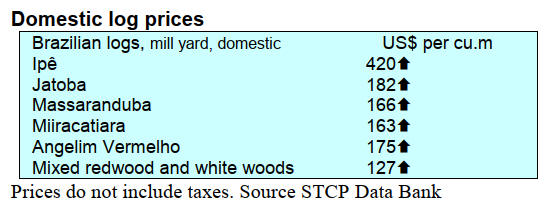 
Through the eyes of industry
The latest GTI report lists the challenges identified by the
private sector in Brazil.
See: https://www.itto-
ggsc.org/static/upload/file/20250819/1755566095153001.pdf
9. PERU
Wood
product exports weakened yet again
Shipments of wood products totalled US$32.48 million
during the first five months of 2025 representing a year on
year decrease of 20% according to the Center for Global
Economy and Business Research of the CIEN-ADEX
Exporters Association.
According to figures from the ADEX Trade Intelligence
System exports included sawnwood (US$12.7 million),
semi-manufactured products (US$9.5 million), firewood
and charcoal (US$3.5 million), furniture and parts
(US$2.3 million) and construction products (US$1.9
million).
The leading destination was the Dominican Republic with
shipments abroad totalling US$6.4 million a 20% increase
compared to the previous year. The United States followed
with US$4.8 million, a decrease of 25% compared to
2024, France with US$3.9 million, a decrease of 40%,
Mexico with US$3.6 million, a decrease of 16% and
rounding out the top 5 is Vietnam with sales of US$3.4
million, an increase of 52%.
Veneer and plywood exports continue to grow
According to information provided by the Services and
Extractive Industries Department of the Association of
Exporters (ADEX), veneer and plywood shipments during
the period January-June 2025 reached an FOB value of
US$1.5 million, a positive change (+56%) compared to the
same period in 2024.
The main market for this sub-sector was Mexico which
accounted for a 41% share and a positive change of 7%
compared to the same period in 2024, followed by
Ecuador with a 33% share. In third place was Colombia
with an 8% share then the Dominican Republic with a 7%
share and rounding out the Top Five was Costa Rica with
a 3% share.
SERFOR and ANIN agreement on restoration projects
The National Forestry and Wildlife Service (SERFOR)
and the National Infrastructure Authority (ANIN) signed
an inter-institutional cooperation agreement to implement
joint actions aimed at restoring degraded forest ecosystems
and promoting natural infrastructure interventions.
This agreement marks a milestone in disaster management
and the promotion of climate-smart investment
contributing to the implementation and sustainability of
projects, investment programmes and natural
infrastructure interventions led by ANIN helping to close
the gap in the area of degraded forest ecosystems.
The Executive Director of SERFOR is quoted as saying
“Conserving our ecosystems is not only an environmental
issue, but also an effective strategy to protect our
communities. Today we are talking about 14 viable
restoration projects in 17 watersheds exposed to the El
Niño phenomenon.
This represents more than 60,000 hectares of land under
restoration, which translates into local employment,
sustainable production chains, the use of native species
and, above all, more opportunities for investors,
companies and communities to work together to build a
more resilient country”.
Forest Management with participation of indigenous
groups
The Ucayali Regional Government, in coordination with
the National Forest and Wildlife Service (SERFOR), held
the first Forest Management (FM) awareness workshop in
the Amazonian Department with the participation of 12
leaders of indigenous organisations.
The president of the Ucayali Regional Organization of
Amazonian Nationalities (ORNAU) emphasised: "It is
important to understand the forest management process as
it will allow us to know when we can develop our forestry
activities and how to continue conserving our forests
within our territories."
Ucayali is the second department to begin establishing
Forest Management Units (FMUs), geographic areas that
serve as a basis for organising, planning and managing the
use of forests and wildlife. Each FMU clearly defines what
activities can be carried out in communal territories, such
as forest harvesting, conservation or the development of
forest plantations.
See: https://www.gob.pe/institucion/serfor/noticias/1231011-
ucayali-impulsa-el-ordenamiento-forestal-con-participacion-de-
organizaciones-indigenas

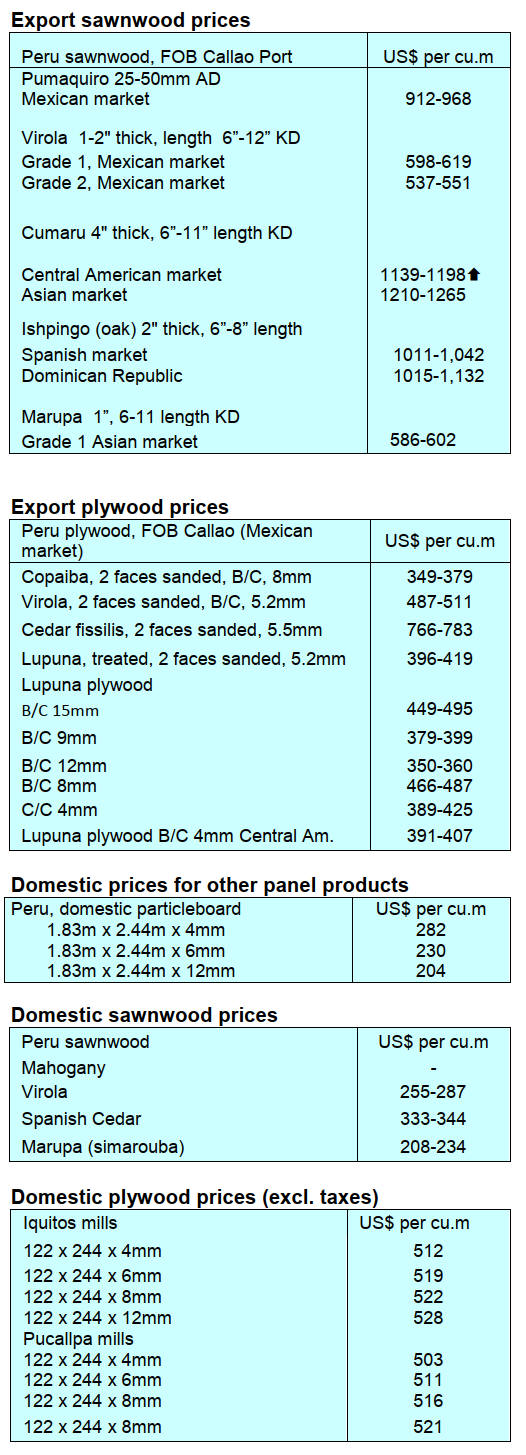
|